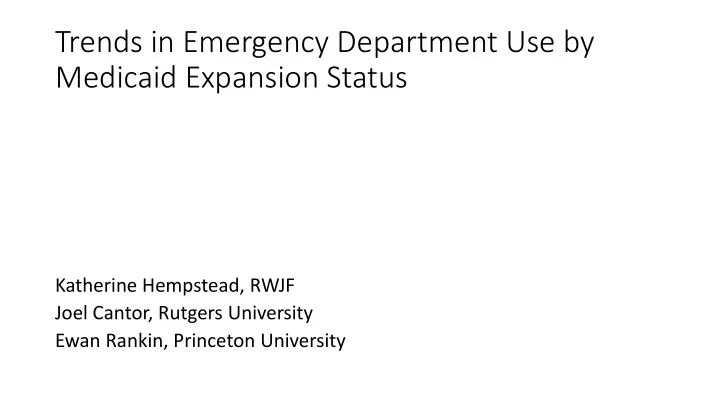

Trends in Emergency Department Use by Medicaid Expansion Status Katherine Hempstead, RWJF Joel Cantor, Rutgers University Ewan Rankin, Princeton University
Background • Some studies have found increase in ED use after Medicaid expansion (OR) • Concern about utilization increases can undermine support for program
How does Medicaid expansion affect ED utilization? • Payer Mix factor • Ignore whether change in coverage status affects utilization • Size of payer mix factor is a function of: • Size of expansion • “Enrollment dynamics” • Compositional factors • Payer mix change related to enrollment change and these other factors • Local and state variation • No implications for Total ED volume
How does Medicaid expansion affect ED utilization? • Utilization factor • Change in coverage status DOES affect individual utilization • Possible pathways: + Coverage effect – increase utilization + “Pent up demand” – increase utilization in SR - Care management – substitute ambulatory care + Network/Access/Delivery System issues - Program features such as co-pays Net effect could be + or - Implications for total ED volume
Measuring the impact of expansion on ED utilization • Payer mix effect certain • Utilization effect uncertain
Measures Payer mix: Change in Medicaid share of ED visits Change in Medicaid ED visits Utilization effect: Change in total ED volume
Prior studies • Hempstead and Cantor (2016) Payor mix, no total increase • Pines (2016) Payer mix, no total increase • Nikpay et al (2017) ** Both!!
HAMP data • Quarterly data from @ 25 state hospital associations • Volume by payer – ED and IP • Several conditions sensitive to coverage • AHRQ PQIs, non-emergency ED visits, TKR • Adding behavioral health
Participating states
Participating states* Expansion Non expansion CO FL CT GA IA KS IL MD IN MO KY NE MN SC MT TN NJ VA NV WI NY WY *TX, LA, MI excluded OH
Measurement of expansion • Coverage variable - accounts for timing and size of expansion • Used KFF data on Medicaid eligibility relative to FPL • Created difference and lagged difference in coverage • Distinguishes between large and small expansions • Distinguishes between early and late expanders
Payer Mix effect: Panel regression results Dependent var: Change in Medicaid Share of Dependent var: Change in Medicaid Share of Emerg Dept Inpatient Coefficient Standard Error* Coefficient Standard Error* Coverage level change: Coverage level change: 𝛾 _current 𝛾 _current year 0.047 0.010 0.023 0.002 year change change 𝛾 _previous 𝛾 _previous 0.021 0.009 0.013 0.006 year change year change Time fixed effects: Time fixed effects: -1. 3 5 -0. 52 𝛾 _2015 0.95 𝛾 _2015 0.65 - 1.27 -0. 31 𝛾 _2016 0.76 𝛾 _2016 0.44 * Clustered at state level * Clustered at state level
Alternative specification: Percent change in Medicaid volume Dependent variable: Annual percentage point Dependent variable: Annual percentage point change in Medicaid Emerg Dept Volumes change in Medicaid In-Patient Volumes Coefficient Standard Error* Coefficient Standard Error* Coverage level change: Coverage level change: 𝛾 _current 𝛾 _current 0.11 0.03 0.25 0.07 year change year change 𝛾 _previous 𝛾 _previous 0.05 0.04 0.07 0.05 year change year change Time fixed effects: Time fixed effects: - 2.34 - 2.6 𝛾 _2015 5.5 𝛾 _2015 7.4 - 3.49 - 6.5 𝛾 _2016 3.5 𝛾 _2016 5.1 * Clustered at state level * Clustered at state level
Interpretation • Significant payer mix effect from expansion • Lagged measure of expansion is smaller • Suggests that effect of expansion declines over time
Test for utilization effect DV: Percent change in total visits Dependent var: Percent change in IP visits Dependent var: Percent change in total ED visits Coefficient Standard Error* Coefficient Standard Error* Coverage level change: Coverage level change: 𝛾 _current 𝛾 _current -.00016 0.0001 0.007 0.017 year change year change 𝛾 _previous 𝛾 _previous -.005 0.03 0.0000143 0.00015 year change year change Time fixed effects: Time fixed effects: - .0005 𝛾 _2015 0.025 𝛾 _2015 1.63 4.89 - .009 - 1.24 𝛾 _2016 0.014 𝛾 _2016 2.31 * Clustered at state level * Clustered at state level
Interpretation No significant effect of expansion on percent change in total ED visits or inpatient admissions No evidence of a “utilization effect” from expansion *Also: robust to a few other specifications
Findings thus far • Finds significant “payer mix” effect, declines over time • No support for overall “utilization” effect • Advantages: timely, more sensitive measure of expansion • Limitations: • Subset of states, may not be representative • Lacks controls, empirical work not complete • PRELIMINARY
Recommend
More recommend